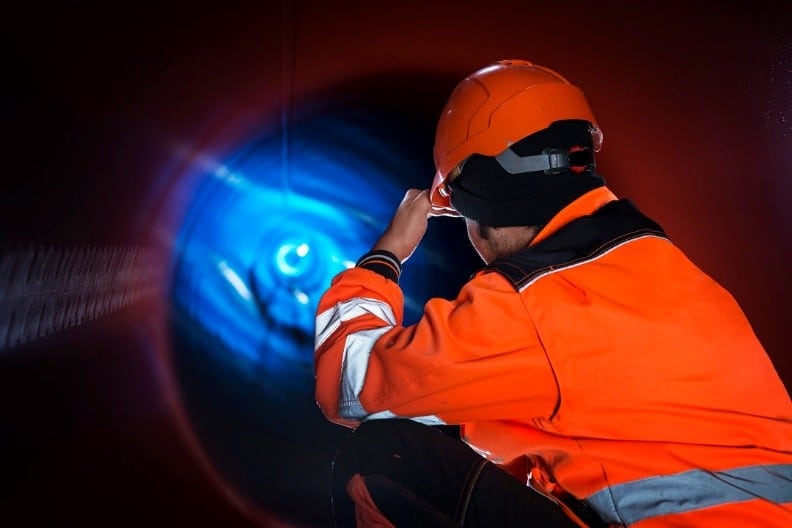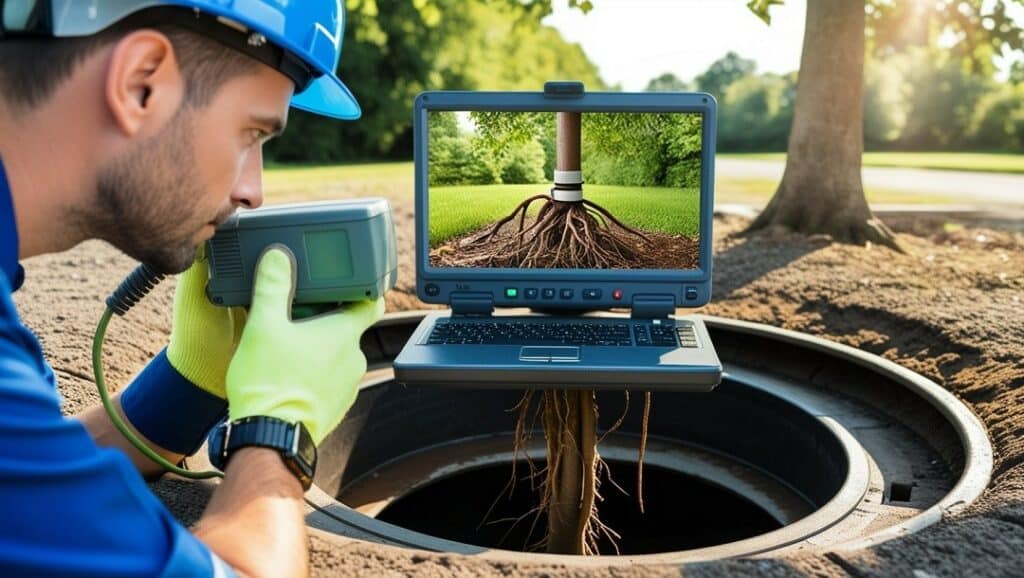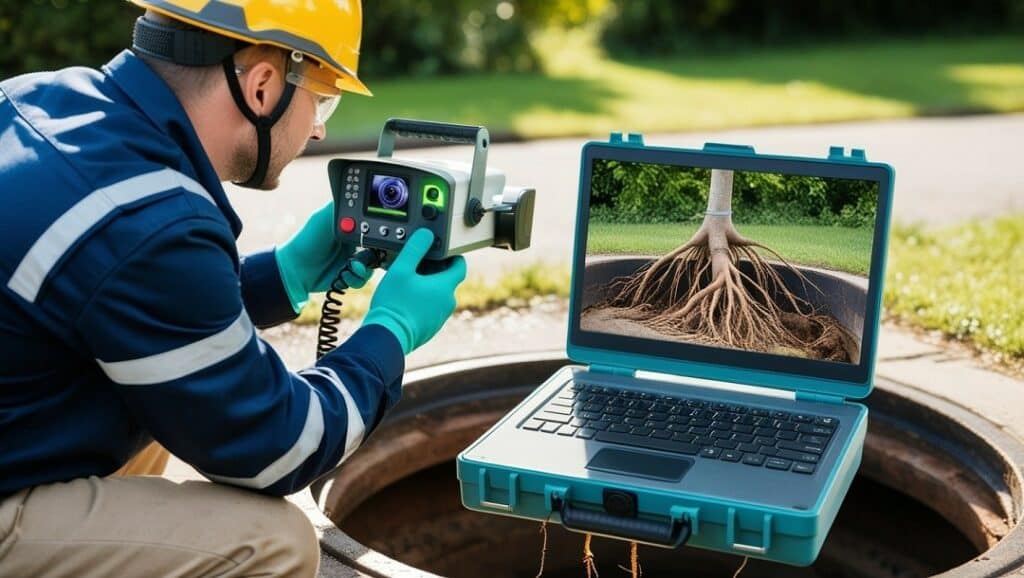
What attracts roots to pipework
Tree roots are naturally drawn to sources of moisture and nutrients. Underground drainage systems, especially older clay or concrete pipes, offer precisely that — a consistent flow of water and organic matter. Small cracks or loose joints in these pipes can release vapour or seepage into the surrounding soil. Roots respond by growing toward these signals, sensing the opportunity to access water and essential nutrients.
Once a root makes contact with a vulnerable part of the pipe, it can infiltrate through even the smallest opening. Over time, this tiny intrusion becomes a larger problem. The roots thicken, multiply, and trap debris passing through the pipe, gradually causing a blockage. What starts as a slow drain often ends with a complete stoppage if left untreated.
Common entry points for roots
Vulnerable areas in a drainage system include joints, cracks, and intersections between different pipe materials. Ageing infrastructure is particularly susceptible, as wear and ground movement can widen access points over time. Where pipes have settled unevenly or shifted due to soil movement, gaps appear and create ideal entry locations.
In some cases, poorly executed installations or substandard repairs also create weaknesses. Misaligned pipework, inferior seals, or incompatible materials leave systems exposed. Once roots find an entry, they rarely retract. Instead, they continue expanding inside the pipe, drawn by the constant flow of water and organic material.
Warning signs of root intrusion
Root ingress rarely announces itself in dramatic fashion at first. One of the earliest indicators is a gurgling sound from the toilet or sink drains. This is often followed by sluggish drainage, where water takes longer to empty. Over time, affected homes may notice repeated clogs, even after attempts to clear them.
Another giveaway is foul odour near drain openings, particularly when no other cause is obvious. In some cases, patches of damp or waterlogging appear outside — often above underground drains — due to slow leakage around root-filled sections. The issue may escalate gradually, but once the roots have taken hold, they can cause structural damage to the pipe itself.
How CCTV Drain Inspection Identifies Root Blockages
What is a CCTV drain inspection?
A CCTV drain inspection involves inserting a high-resolution camera into the drainage system to provide a live visual feed of the internal pipework. This non-invasive diagnostic method allows engineers to assess the exact condition of the drains without needing to excavate or disrupt the surrounding area.
The camera is mounted on a flexible rod or remotely controlled crawler unit, depending on the layout and scale of the system. It transmits footage to a monitor in real-time, helping drainage professionals detect obstructions, root ingress, cracks, and structural weaknesses inside the pipe. This approach allows for faster identification of blockages with minimal disruption to the property.
Advantages over traditional diagnostic methods
Unlike traditional approaches — which often rely on guesswork, surface-level symptoms, or exploratory digging — CCTV drain inspection is precise and efficient. It allows for a full survey of the system, revealing the type, location, and severity of any blockages, including tree root infestations.
Traditional rodding or flushing methods may clear a blockage temporarily but do little to reveal why it occurred. In contrast, a camera inspection shows whether roots are growing within the pipe, whether multiple areas are affected, and whether pipe replacement or sealing might be needed to prevent recurrence.
This clarity helps avoid unnecessary repair work, reduces costs, and supports better decision-making. It also provides clear visual evidence, which is particularly valuable when dealing with insurance claims or disputes involving property boundaries or shared drainage systems.
How footage pinpoints the exact blockage location
Modern camera systems used in CCTV camera drain inspection are often equipped with built-in transmitters and sensors. These tools allow operators to not only see the obstruction but also record its depth and position. Surface-level tracking equipment can then identify the precise location of the issue from above ground.
This targeted approach eliminates guesswork. Engineers know exactly where to dig or apply treatment methods, which makes the process far quicker and far less invasive than older alternatives. It also helps to distinguish between isolated and widespread problems, shaping a repair strategy tailored to the drainage system’s actual condition.

What to Expect During a CCTV Camera Drain Inspection
Equipment involved
A standard CCTV camera drain inspection makes use of purpose-built technology designed for confined, underground environments. The setup typically includes a waterproof camera mounted on a flexible cable or crawler, a portable monitor, and a control unit. For domestic drains, push-rod cameras are often sufficient. For more complex networks, particularly on commercial or larger residential sites, crawler units with pan-and-tilt capabilities provide greater reach and clarity.
Many of these systems include integrated lighting to illuminate the interior of the pipe, allowing the technician to record clear footage regardless of depth or diameter. Most setups also feature measurement tools and sonde locators, which are crucial for mapping the drain layout and marking problem areas at surface level.
Inspection process step by step
The process begins with a basic access check. An engineer locates the nearest manhole or inspection chamber and lowers the camera into the drain. As the camera progresses, the technician monitors the live feed, looking for signs of damage, misalignment, or root intrusion. Depending on the condition and accessibility of the system, the inspection can take anywhere from 30 minutes to a few hours.
Footage is recorded and reviewed in detail after the on-site survey. Still images are often captured of significant findings. A full report is compiled, outlining any blockages, root ingress, or structural faults discovered during the process. This is especially useful when preparing quotes, recommending repairs, or submitting documentation for third parties.
Interpreting the findings
Root intrusion appears on the footage as tangled masses, typically white or brown, forcing their way through joints or cracks. In more severe cases, the camera may show standing water behind a dense clump of roots, suggesting a partial or complete blockage. The footage also highlights any structural issues, like pipe collapse or misaligned sections, which may have contributed to the root entry in the first place.
The inspection report classifies the severity of the problem and may include grading for each defect found. This helps property owners or site managers understand whether immediate action is required or whether preventative maintenance would be enough to manage the issue. It also ensures transparency — there’s visual evidence to support every recommendation.
Techniques Used to Clear Roots from Drain Pipes
Mechanical cutting tools
One of the most effective methods for removing tree roots involves mechanical cutters. These tools, attached to a rotating cable or robotic arm, slice through root masses and dislodge them from within the pipe. They’re particularly useful for larger root systems that have become entangled deep in the drain network.
Cutters are inserted through access points, such as manholes, and operated remotely. As the blades rotate, they shred roots into fragments small enough to be flushed away. This approach is efficient but must be handled carefully — aggressive cutting can damage already weakened pipes if not properly assessed beforehand.
High-pressure water jetting
Jetting is another method used to clear roots from drain pipes. This technique involves blasting water through a nozzle at extremely high pressure to break apart root masses, grease, or other debris. It’s especially useful when combined with mechanical cutting, ensuring the full removal of all remaining residue.
In addition to clearing obstructions, jetting can help clean the pipe walls, reducing the chance of immediate re-growth. While it doesn’t physically remove the root source from outside the pipe, it does restore flow and is often a vital step before repair or sealing.
Root barrier installation
After removing the roots, long-term prevention becomes essential. One option is the installation of a root barrier — a physical or chemical deterrent placed near the affected drain line. These barriers prevent roots from returning to the same entry point, particularly in areas where trees or shrubs cannot be relocated.
In some cases, re-lining the affected pipe with a resin-impregnated sleeve (also known as cured-in-place pipe lining) is recommended. This not only blocks the previous entry point but also strengthens the pipe internally, sealing cracks and joints that previously allowed ingress.

Drain Surveying as a Preventative Measure
Periodic inspections for older properties
Older properties, particularly those with clay or pitch fibre pipework, are more prone to damage from tree roots. As materials degrade over time, small fractures and misalignments become common, creating easy access points for roots to infiltrate. In such cases, drain surveying is an essential preventative tool.
Periodic CCTV drain inspections can help spot early signs of deterioration, even before any symptoms appear indoors. This proactive approach allows property owners to carry out minor repairs or maintenance before costly and disruptive blockages occur. It’s especially helpful in locations with mature trees or fast-growing root systems.
Surveying before home extensions or landscaping
Planning a home extension, conservatory, or significant garden landscaping often requires an assessment of underground drainage. Tree roots can cause complications during building work, particularly if they’re growing close to pipes that need to be relocated or connected to new systems.
Drain surveying at this stage avoids nasty surprises. Engineers can map the entire system, identify weak spots, and highlight any existing root intrusion that may be disturbed during construction. With this information in hand, developers and homeowners can avoid accidental pipe damage and comply with building regulations more confidently.
Long-term benefits of proactive maintenance
CCTV drain inspection doesn’t just serve short-term repair work. It plays a vital role in long-term drainage health. By scheduling routine inspections — every few years or following heavy root seasons — property owners can drastically reduce the chance of recurring issues.
When combined with other maintenance practices such as jetting or sealing, regular drain surveys help extend the life of pipework and keep systems functioning efficiently. This reduces emergency callouts, prevents property damage, and limits the need for excavation, all while preserving landscaping and structural integrity.
Signs It’s Time to Book a CCTV Drain Inspection
Recurring blockages
If clogs return again shortly after being cleared, it’s often a sign that the underlying issue hasn’t been addressed. While plunging or rodding might offer a temporary fix, root ingress or structural defects require more than surface-level solutions. CCTV drain inspection reveals what’s really happening inside the pipe, ensuring a targeted resolution.
Repeated use of drain-clearing chemicals or tools without success is another red flag. These methods can even worsen damage to ageing pipes. An inspection eliminates guesswork and identifies the real cause — whether it’s roots, scale build-up, or collapsed sections.
Slow draining sinks or toilets
Drains that take longer than usual to empty could indicate a partial blockage somewhere in the system. This may be caused by encroaching tree roots that restrict water flow or snag solid materials as they pass. In early stages, water may eventually drain away, but the issue will worsen over time if left unchecked.
Using a CCTV camera allows technicians to find the obstruction without the need for invasive digging. The footage reveals whether slow flow is due to a single problem or several contributing factors, such as silt build-up in combination with root growth.
Unexplained smells or patches of damp
Persistent foul odours near drains, manholes, or gully traps often point to problems underground. When tree roots damage pipework, they can cause leaks that allow waste material to escape into the surrounding soil. This produces unpleasant smells and may result in soggy patches or vegetation overgrowth in unexpected areas.
Damp areas on walls or floors, particularly if close to exterior drains or bathroom pipework, may also be connected to root-related issues. In these cases, a CCTV inspection is the quickest way to confirm the cause without tearing up flooring or driveways.
Why Professional Inspection Matters
DIY risks and limitations
Attempting to diagnose or resolve drainage problems without professional tools often leads to misdiagnosis or incomplete fixes. Standard drain rods may push blockages further down the line or create temporary clearances that mask a larger problem. When tree roots are involved, these methods rarely address the root cause — literally or figuratively.
Without camera footage, it’s impossible to know whether the issue is a collapsed section, root intrusion, or both. Home remedies and over-the-counter chemicals may provide a short-term solution, but they can damage pipes and harm the environment if misused. In many cases, DIY efforts delay proper repairs and increase long-term costs.
Accuracy and efficiency from trained technicians
Trained drainage specialists bring more than equipment — they bring experience. A professional team can interpret CCTV drain inspection footage accurately, spotting issues that would go unnoticed by an untrained eye. Their knowledge ensures that every blockage is not just cleared, but understood.
This precision leads to faster diagnoses, fewer call-backs, and repair work that genuinely resolves the issue. Whether clearing roots from drain pipes or recommending structural repairs, professionals ensure that work is tailored to the specific condition of the drainage network.
Additionally, professionals are often equipped with more advanced tools, such as sonar locators, cutting heads, and high-capacity jetting systems. These allow for immediate action following the inspection, saving time and restoring full function to the drainage system without unnecessary disruption.
Supporting evidence for insurance claims or repairs
When damage caused by root ingress is substantial, having a CCTV report can be essential in dealing with insurers or property managers. The footage serves as concrete evidence of what’s happening underground, showing not only the extent of the problem but also the likely cause and urgency of the repair.
Some insurance policies require proof that the issue wasn’t due to neglect or misuse. A detailed inspection report, accompanied by images or video stills, supports the case for coverage. It also helps when coordinating with third parties, such as water companies or contractors, especially in cases where shared drains are involved.
In many cases, the inspection becomes part of the property’s documented maintenance history — a useful asset for future sales or valuation, showing that the drainage system has been professionally maintained and assessed.
CCTV drain inspection offers a clear, reliable, and efficient way to detect tree root blockages before they become serious. Whether used to solve a current problem or prevent a future one, it gives property owners the information they need to act with confidence and avoid unnecessary costs.
Recent Posts
- Guide to Clearing Blocked Drains: Causes & Solutions November 24, 2025
- Drainage Jetting Explained: How It Clears Blocked Drains October 25, 2025
- Clean Out Gutters Like a Pro: Step-by-Step Guide October 25, 2025
- CCTV Drain Inspection for Detecting Tree Root Blockages August 14, 2025
- How To Clear Roots From Drain Pipes July 11, 2025
Categories
- Drain Repairs (40)
- Drain Surveys (24)
- Drain Unblocking (60)
- Rodent Drain Problems (1)
- Uncategorized (2)
- Vacuum Tankers (2)
